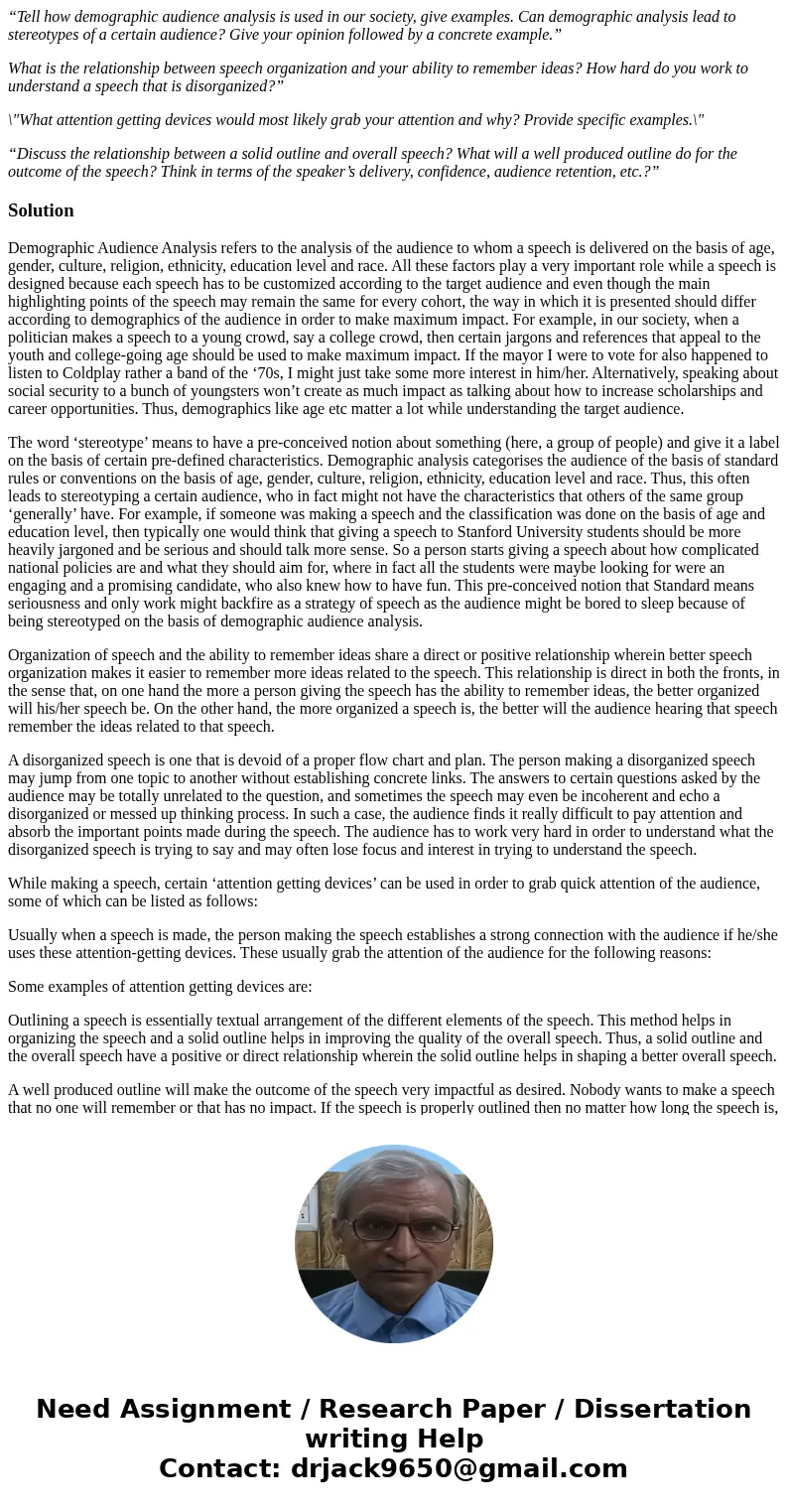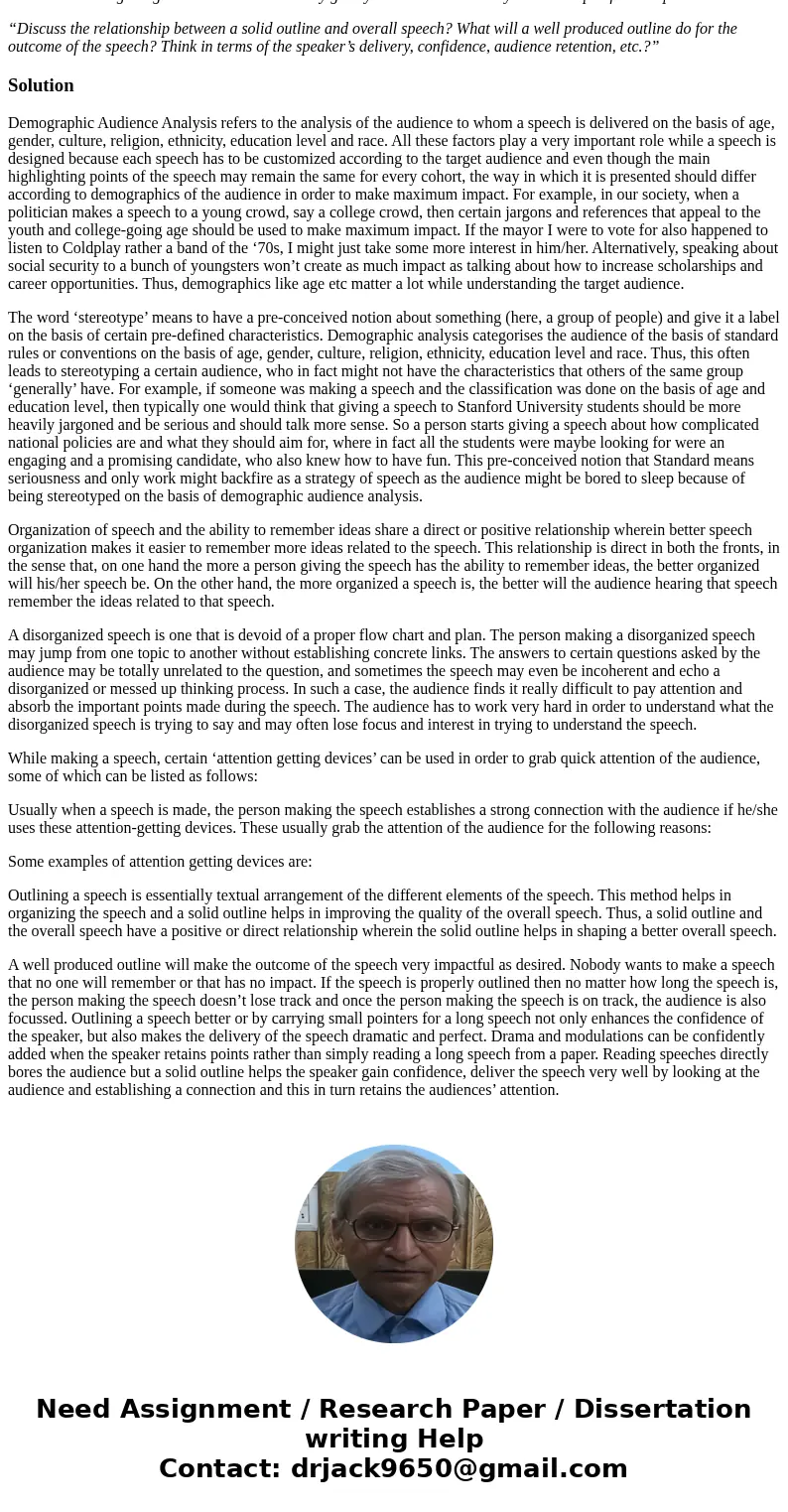Tell how demographic audience analysis is used in our societ
“Tell how demographic audience analysis is used in our society, give examples. Can demographic analysis lead to stereotypes of a certain audience? Give your opinion followed by a concrete example.”
What is the relationship between speech organization and your ability to remember ideas? How hard do you work to understand a speech that is disorganized?”
\"What attention getting devices would most likely grab your attention and why? Provide specific examples.\"
“Discuss the relationship between a solid outline and overall speech? What will a well produced outline do for the outcome of the speech? Think in terms of the speaker’s delivery, confidence, audience retention, etc.?”
Solution
Demographic Audience Analysis refers to the analysis of the audience to whom a speech is delivered on the basis of age, gender, culture, religion, ethnicity, education level and race. All these factors play a very important role while a speech is designed because each speech has to be customized according to the target audience and even though the main highlighting points of the speech may remain the same for every cohort, the way in which it is presented should differ according to demographics of the audience in order to make maximum impact. For example, in our society, when a politician makes a speech to a young crowd, say a college crowd, then certain jargons and references that appeal to the youth and college-going age should be used to make maximum impact. If the mayor I were to vote for also happened to listen to Coldplay rather a band of the ‘70s, I might just take some more interest in him/her. Alternatively, speaking about social security to a bunch of youngsters won’t create as much impact as talking about how to increase scholarships and career opportunities. Thus, demographics like age etc matter a lot while understanding the target audience.
The word ‘stereotype’ means to have a pre-conceived notion about something (here, a group of people) and give it a label on the basis of certain pre-defined characteristics. Demographic analysis categorises the audience of the basis of standard rules or conventions on the basis of age, gender, culture, religion, ethnicity, education level and race. Thus, this often leads to stereotyping a certain audience, who in fact might not have the characteristics that others of the same group ‘generally’ have. For example, if someone was making a speech and the classification was done on the basis of age and education level, then typically one would think that giving a speech to Stanford University students should be more heavily jargoned and be serious and should talk more sense. So a person starts giving a speech about how complicated national policies are and what they should aim for, where in fact all the students were maybe looking for were an engaging and a promising candidate, who also knew how to have fun. This pre-conceived notion that Standard means seriousness and only work might backfire as a strategy of speech as the audience might be bored to sleep because of being stereotyped on the basis of demographic audience analysis.
Organization of speech and the ability to remember ideas share a direct or positive relationship wherein better speech organization makes it easier to remember more ideas related to the speech. This relationship is direct in both the fronts, in the sense that, on one hand the more a person giving the speech has the ability to remember ideas, the better organized will his/her speech be. On the other hand, the more organized a speech is, the better will the audience hearing that speech remember the ideas related to that speech.
A disorganized speech is one that is devoid of a proper flow chart and plan. The person making a disorganized speech may jump from one topic to another without establishing concrete links. The answers to certain questions asked by the audience may be totally unrelated to the question, and sometimes the speech may even be incoherent and echo a disorganized or messed up thinking process. In such a case, the audience finds it really difficult to pay attention and absorb the important points made during the speech. The audience has to work very hard in order to understand what the disorganized speech is trying to say and may often lose focus and interest in trying to understand the speech.
While making a speech, certain ‘attention getting devices’ can be used in order to grab quick attention of the audience, some of which can be listed as follows:
Usually when a speech is made, the person making the speech establishes a strong connection with the audience if he/she uses these attention-getting devices. These usually grab the attention of the audience for the following reasons:
Some examples of attention getting devices are:
Outlining a speech is essentially textual arrangement of the different elements of the speech. This method helps in organizing the speech and a solid outline helps in improving the quality of the overall speech. Thus, a solid outline and the overall speech have a positive or direct relationship wherein the solid outline helps in shaping a better overall speech.
A well produced outline will make the outcome of the speech very impactful as desired. Nobody wants to make a speech that no one will remember or that has no impact. If the speech is properly outlined then no matter how long the speech is, the person making the speech doesn’t lose track and once the person making the speech is on track, the audience is also focussed. Outlining a speech better or by carrying small pointers for a long speech not only enhances the confidence of the speaker, but also makes the delivery of the speech dramatic and perfect. Drama and modulations can be confidently added when the speaker retains points rather than simply reading a long speech from a paper. Reading speeches directly bores the audience but a solid outline helps the speaker gain confidence, deliver the speech very well by looking at the audience and establishing a connection and this in turn retains the audiences’ attention.


 Homework Sourse
Homework Sourse